![]()
Dr.
Wankel's Engine
RX-7's are powered
by the Wankel Rotary Engine. The  remarkable design of this 1.3 liter
engine
remarkable design of this 1.3 liter
engine  allows it to
produce significant horsepower (112hp+ per liter). It was the
design of a person by the name of Dr. Felix Wankel. Dr. Wankel
proposed his engine design to many automakers but many
reluctantly choose to follow through with his ideas. In its early
days of production, the engines were prone to leaks and others
problems. Today, the Wankel Rotary engine has been researched and
developed to obtain the utmost reliability and derivability.
Mazda has done this through it workings with the RX-7. In the
late 80's, Mazda added a turbo to one of their models and named
it the TURBO II. Unfortunately, the TURBO II engine never saw its
way onto a production convertible (not in the USA, anyways). Many
people have taken on the project of transplanting a turbo into a
convertible to make the "Ultimate Conversion."
allows it to
produce significant horsepower (112hp+ per liter). It was the
design of a person by the name of Dr. Felix Wankel. Dr. Wankel
proposed his engine design to many automakers but many
reluctantly choose to follow through with his ideas. In its early
days of production, the engines were prone to leaks and others
problems. Today, the Wankel Rotary engine has been researched and
developed to obtain the utmost reliability and derivability.
Mazda has done this through it workings with the RX-7. In the
late 80's, Mazda added a turbo to one of their models and named
it the TURBO II. Unfortunately, the TURBO II engine never saw its
way onto a production convertible (not in the USA, anyways). Many
people have taken on the project of transplanting a turbo into a
convertible to make the "Ultimate Conversion."
Here are some more
images of the rotary engine,

| Piston | Description | Rotary |
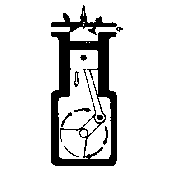 |
Intake An intake event occurs when there is a chamber with an expanding volume open to the intake system. On a piston engine, this is when the intake valve is open and the piston is moving down. Intake on a rotary takes place when the intake ports are uncovered by the rotor, at which time the chamber open to the port will be increasing in volume. |
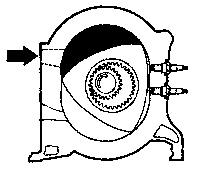 |
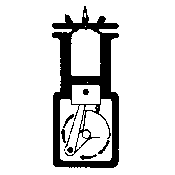 |
Compression A closed chamber decreasing in volume describes the compression cycle. A piston engine is in compression when the valves are closed and the piston is moving upward. Compression is achieved on a rotary as a result of the rotor moving in its housing such that the volume of its closed chamber is decreased. |
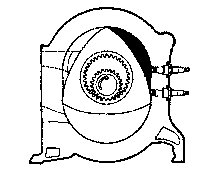 |
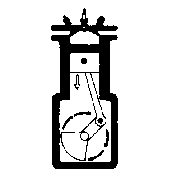 |
Power/Expansion The power or expansion cycle begins as the compressed intake charge is ignited by a spark. The gas expands as it is heated by the burning fuel. An engine gets its power by harnessing this expanding gas. In a conventional engine, this force pushes the piston downward which works to turn the crankshaft. In a rotary engine, this force pushes rotor in a direction that expands chamber containing the burning gases and in the process rotates the eccentric shaft. |
 |
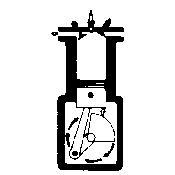 |
Exhaust The exhaust cycle clears the contents of the chamber preparing it for another full cycle. This is achieved in a conventional engine by opening the exhaust valve as momentum carries the piston upward. In a rotary, the leading apex of the combusting chamber uncovers the exhaust port in the rotor housing through which the spent charge is exhausted. |
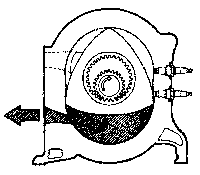 |